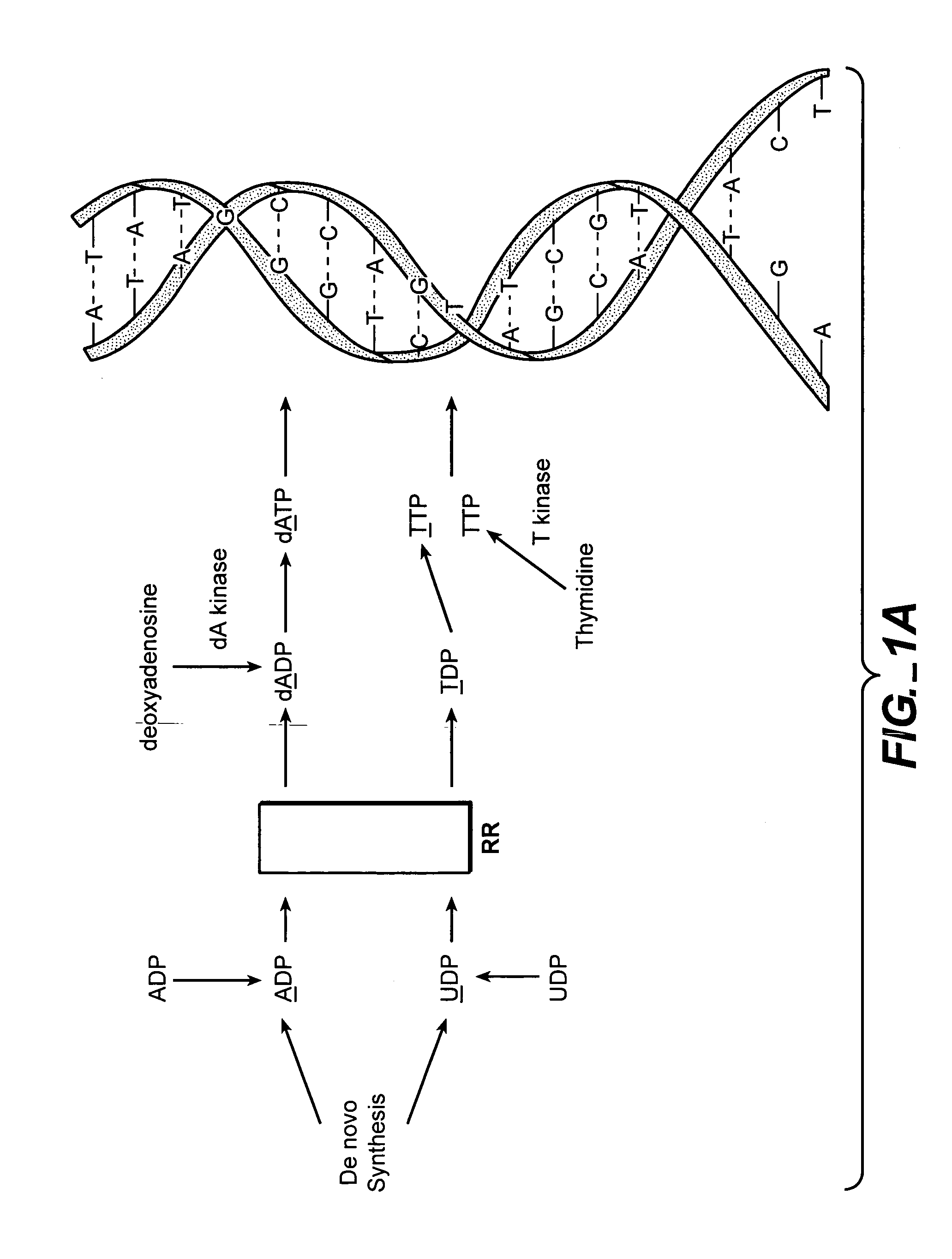In vivo measurement of the relative fluxes through ribonucleotide reductase vs. deoxyribonucleoside pathways using isotopes
a ribonucleotide reductase and relative flux technology, applied in the field of cell proliferation measurement and cell proliferation change, can solve the problems of inability to study these metabolic processes in vivo, gap in methodology is important limitation, and no means of identifying this scenario, etc., to achieve the effect of increasing the activity of thymidine kinase, reducing relative contribution, and increasing the salvage rate of thymidin
- Summary
- Abstract
- Description
- Claims
- Application Information
AI Technical Summary
Benefits of technology
Problems solved by technology
Method used
Image
Examples
example 1
Measurements of Cell Proliferation in Hydroxyurea-Treated MCF7 Cells
[0202] Introduction:
[0203] As discussed, supra, the inhibition of RR is a clincally relevant mechanism of action for the treatment of many conditions, including some cancers. Many cancer drugs are evaluated in cell culture systems prior to their evaluation in animal models. Most of these cell culture models rely on tumor cell lines, which are “immortal” and fast-growing. MCF7 cells are derived from a mammary tumor, and are a commonly used cell type that can be used for in vitro (cell culture) evaluation of therapeutics, or can be implanted into mice to create tumors for in vivo evaluation of therapeutics. Hydroxyurea is a known RR inhibitor, and has strong activity in cell culture and in vivo.
[0204] Methods:
[0205] Mammary carcinoma cells (MCF7) were grown under standard conditions to approximately 50% confluence. Media was removed and replaced with media containing 10% 2H2O, 10 □M dN's and hydroxyurea at various...
example 2
Cell Proliferation and RR Inhibition Compared in SW1573 Cells
[0214] Introduction:
[0215] SW1573 cells are lung cancer-derived and are also frequently used for in vitro studies (see introduction in Example 1, supra). The present invention was applied to the study of these cells as well. In this case, two anti-RR therapeutics, HU and gemcitabine were used, allowing for a comparison of the two to be made.
[0216] Methods:
[0217] Non-small cell lung carcinoma cells (SW1573) were grown under standard conditions to approximately 50% confluence. Media was removed and replaced with media containing 4% 2H2O, 1 □M dN's and hydroxyurea or gemcitabine at various concentrations. Cells were grown for and additional 24 hours after which they were harvested and frozen. Cell proliferation and RR inhibition was performed as described, supra.
[0218] Results:
[0219]FIGS. 4 and 5 show the effect of HU and gemcitabine on the proliferation and RR activity of cultured SW1573 cells. As FIG. 5 shows, apparen...
example 3
Determination of RR Inhibition in Mouse Tumor Cells and Bone Marrow Cells Over 5 Days of Chemotherapy Treatment
[0222] Introduction:
[0223] Immortal or cancer-derived cell lines can be implanted into mice in order to grow tumors. This implantation of tumor cells creates an in vivo model of cancer that is widely used. EMT7 cells are mammary-tumor derived.
[0224] Methods:
[0225] Female balb / C mice were implanted subcutaneously with approximately 106 EMT7 mouse mammary carcinoma cells in matrigel and allowed to reach ca.1500 mm3.
[0226] Mice were labeled with 2H2O with an i.p. bolus and treatment with either 125 mg / kg gemcitabine (Gem) or 500 mg / kg HU began. Gem was administered every other day, HU daily. At then end of 5 days tumors were removed, measured, homogenized and DNA was isolated as described, supra. Bone marrow was isolated using standard techniques. Bone marrow DNA was isolated as described, supra. GC / MS analysis was described as carried out, and calculations of RR activity...
PUM
| Property | Measurement | Unit |
|---|---|---|
| Molar concentration | aaaaa | aaaaa |
| time | aaaaa | aaaaa |
| time | aaaaa | aaaaa |
Abstract
Description
Claims
Application Information
 Login to View More
Login to View More - R&D
- Intellectual Property
- Life Sciences
- Materials
- Tech Scout
- Unparalleled Data Quality
- Higher Quality Content
- 60% Fewer Hallucinations
Browse by: Latest US Patents, China's latest patents, Technical Efficacy Thesaurus, Application Domain, Technology Topic, Popular Technical Reports.
© 2025 PatSnap. All rights reserved.Legal|Privacy policy|Modern Slavery Act Transparency Statement|Sitemap|About US| Contact US: help@patsnap.com



